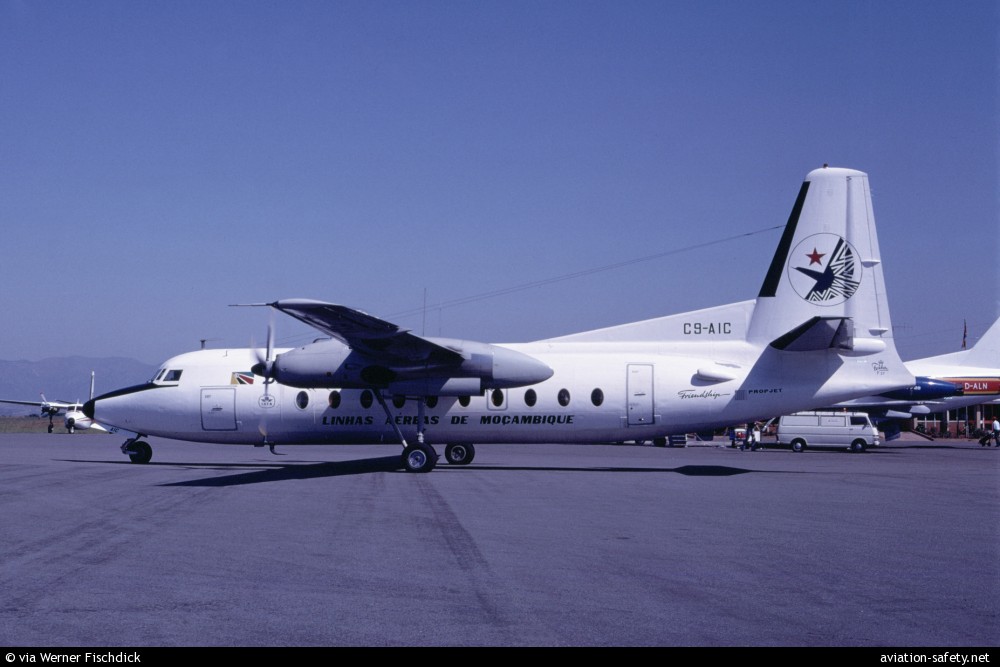
| Date: | Monday 12 February 1990 |
| Time: | 09:29 |
| Type: |  Fokker F-27 Friendship 200 |
| Owner/operator: | TAM Transportes Aéreos Regionais |
| Registration: | PT-LCG |
| MSN: | 10206 |
| Year of manufacture: | 1962 |
| Fatalities: | Fatalities: 1 / Occupants: 41 |
| Other fatalities: | 2 |
| Aircraft damage: | Destroyed, written off |
| Category: | Accident |
| Location: | Bauru Airport, SP (BAU) -
 Brazil Brazil
|
| Phase: | Initial climb |
| Nature: | Passenger - Scheduled |
| Departure airport: | São Paulo-Congonhas Airport, SP (CGH/SBSP) |
| Bauru Airport, SP (BAU/SBBU) | |
| Investigating agency: | CENIPA |
| Confidence Rating: |
The F-27 Friendship departed Sao Paulo-Congonhas (CGH) on a domestic flight to Bauru. Pilot flying was a captain in training, accompanied by an instructor and a commissioner. Due to congestion in the frequency of Brasilia ACC, the descent from FL140 was initiated while the airplane was 27 nm (50 km) from Bauru, instead of the usual 40nm (74 km) out. After a fast descent to 4000 feet the IFR flight plan was cancelled and the crew proceeded for a visual straight-in approach to runway 32. The pilot flying felt uncomfortable because the airplane was flying too fast and was too close to the airfield. The instructor wanted to continue the approach and instructed the landing gear to be lowered and the flaps to be selected down from 16 to 40 degrees. The airplane decelerated to 135 kts, which was still too fast. After asking the instructor, the pilot was told that he was supposed to carry out the approach and landing. Because the instructor also held his control column and due to the improper approach configuration, the pilot again asked who would perform the landing. The instructor now took over control. The F-27 descended at a rate of 2500 fpm and the speed was still 130 kts. The airplane touched down 775 m past the runway 32 threshold. The aircraft floated and alternatingly, touched the runway with the right and left main landing gear. The instructor realized that the plane could not be stopped on the remaining runway, and brusquely added power to initiate a go around. Contrary to the Airplane Flight Manual, power was not added gradually thus causing an extreme rise in the turbine gas temperature (TGT). The engine´s combustion chambers had now received excessive from fuel. The low rotations of the propellers did not provide enough air for a combustive mixture and the high angle of attack on the initial climb provoked the intake of enough air into the engines. Both engines failed to develop enough power and the Fokker began to sank until it collided with some obstacles on the ground, 600 m outside the airport. Two occupants of a car that was hit, didn't survive.
CONCLUSÃO:
Fator Humano - Aspecto Psicológico - Contribuiu
Fator Operacional - Contribuiu
(1) Deficiente Instrução.
(2) Deficiente Aplicação dos Comandos.
(3) Deficiente Coordenação de Cabine.
(4) Deficiente Julgamento.
(5) Deficiente Planejamento.
(6) Deficiente Supervisão.
Accident investigation:
 |
|
Sources:
CENIPA - Centro de Investigação e Prevenção de Acidentes Aeronáuticos
ICAO Adrep Summary 2/90 (#12)
Location
Images:

photo (c) via Werner Fischdick; Manzini-Matsapha International Airport (MTS/FDMS); May 1979
Revision history:
| Date/time | Contributor | Updates |
|---|
The Aviation Safety Network is an exclusive service provided by:


 ©2024 Flight Safety Foundation
©2024 Flight Safety Foundation